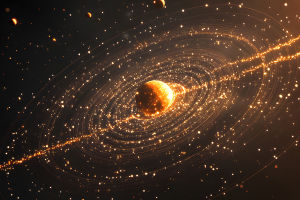Imagine a planet so massive that 1,300 Earths could vanish inside it. Jupiter, the solar system's largest inhabitant, dwarfs everything in its vicinity.
Let's dive into the mind-blowing numbers behind this gas giant.
Jupiter's Mind-Blowing Dimensions
Let's start with the numbers. Jupiter boasts a diameter of 86,881 miles—so vast that its equator alone could stretch longer than a round-trip flight from New York to Sydney, multiplied by ten. To put it another way, if you lined up 11 Earths side by side, you'd barely match Jupiter's width. Its volume is equally staggering: you could fit 1,300 Earths inside Jupiter with room to spare.
Yet, despite its immense size, Jupiter isn't as dense as our rocky planet. Composed mostly of hydrogen and helium, it's a fluffy giant—its mass equals 317 Earths, but its low density means you'd weigh just 2.4 times more on Jupiter than you do here.
The Fastest Spinner in the Solar System
Jupiter isn't just big—it's also the speed demon of our planetary neighborhood. While Earth takes a leisurely 24 hours to complete a rotation, Jupiter whirls around in just 10 hours, making its days the shortest of any planet.
This rapid spin doesn't just give Jupiter a short day—it also flattens the planet into an oblate spheroid, meaning its equator bulges outward while its poles are slightly squashed. Imagine spinning a ball of pizza dough so fast that the middle puffs out—that's Jupiter in a nutshell. This distortion is visible even in amateur telescopes, giving the planet its characteristic "squashed" appearance.
Earth vs. Jupiter: A David and Goliath Story
Comparing Earth to Jupiter is like comparing a pebble to a boulder. If Earth were the size of a nickel, Jupiter would be a football. Its surface area spans a mind-numbing 23 billion square miles—enough to cover Earth 122 times over.
But here's the real kicker: despite its gargantuan size, Jupiter's gravity is only 2.4 times stronger than Earth's. That's because gravity depends on mass, not size, and Jupiter's gaseous composition makes it far less dense than our rocky home.
Traveling Around Jupiter: A Journey of Epic Proportions
Ever wondered how long it would take to circumnavigate Jupiter? Strap in, because the numbers are staggering. If you tried to walk around Jupiter at a brisk pace (say, 3 mph), it would take you 10.4 years—nonstop. Hop on a bicycle (15 mph), and you'd still need 2.1 years of pedaling.
Even in a speeding car (70 mph), the trip would last 5.4 months. And if you opted for a Boeing 747 cruising at 600 mph, you'd spend 19 days in the air—just to loop around once. These numbers aren't just fun facts—they're a visceral reminder of Jupiter's incomprehensible scale.
The Failed Star: Jupiter's Identity Crisis
Jupiter's composition—90% hydrogen and helium—mirrors that of the Sun, leading some scientists to call it a "failed star." So why didn't it ignite into a star? The answer lies in its mass. While Jupiter is massive by planetary standards, it's still 75 times too small to trigger the nuclear fusion needed to become a star.
Yet, Jupiter isn't just a passive giant—it radiates more heat than it receives from the Sun, possibly leftover energy from its formation billions of years ago. Some even speculate that if Jupiter had been just a bit bigger, our solar system might have had two suns.
A Cosmic Perspective
Jupiter isn't just another planet—it's a celestial titan that forces us to rethink our place in the universe. Its mind-bending size, dizzying rotation, and star-like ingredients make it one of the most fascinating objects in our solar system.
Next time you gaze up at the night sky, remember: that tiny, bright dot you see isn't just a planet—it's a monstrous world that could fit all of humanity's dreams (and then some) inside it. Jupiter's grandeur serves as a humbling reminder that in the vast cosmic ocean, Earth is but a drop—and that's what makes exploring the universe so thrilling.


